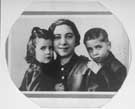
|
|
|

|

|

|

|
|
Click on an image to see a larger, more detailed picture.
|
|
|
|
|
| 1943: Death and Resistance |

|
pg. 467 |

|
|
|
|
| |
 A longtime Nazi, Odilo Globocnik joined the Party in Austria in 1931. Before the Anschluss (annexation), he worked to increase the Party's numbers and influence. Following the Anschluss, Globocnik's obedient service in the SS earned him the position of Gauleiter of Vienna, an office from which he was later fired due to corruption. Putting Globocnik's ambition and slavish obedience to use, Heinrich Himmler pardoned him and placed him in charge of the Lublin region of Poland. Globocnik oversaw the building of Majdanek, Belzec, Sobibór, and Treblinka, and controlled forced labor and extermination until August 1943.
A longtime Nazi, Odilo Globocnik joined the Party in Austria in 1931. Before the Anschluss (annexation), he worked to increase the Party's numbers and influence. Following the Anschluss, Globocnik's obedient service in the SS earned him the position of Gauleiter of Vienna, an office from which he was later fired due to corruption. Putting Globocnik's ambition and slavish obedience to use, Heinrich Himmler pardoned him and placed him in charge of the Lublin region of Poland. Globocnik oversaw the building of Majdanek, Belzec, Sobibór, and Treblinka, and controlled forced labor and extermination until August 1943.
Photo: Ullstein Bilderdienst
|
 A barracks at the Auschwitz concentration camp is lined with triple-tiered wood bunk beds, on which inmates slept. Each level was shared by more than one person and often lined with little more than a thin blanket. Survivors describe the sleep routines with mixed feelings. Whereas most viewed their bunks as refuge from the day's precarious and dangerous existence, the nights were also filled with terror. The nocturnal ragings of drunk Kapos, ceaseless struggles with bunkmates, and the relentless trips to latrines and chamber pots punctuate the memories of survivors.
A barracks at the Auschwitz concentration camp is lined with triple-tiered wood bunk beds, on which inmates slept. Each level was shared by more than one person and often lined with little more than a thin blanket. Survivors describe the sleep routines with mixed feelings. Whereas most viewed their bunks as refuge from the day's precarious and dangerous existence, the nights were also filled with terror. The nocturnal ragings of drunk Kapos, ceaseless struggles with bunkmates, and the relentless trips to latrines and chamber pots punctuate the memories of survivors.
Photo: Panstwowe Muzeum Oswiecim
|
 As part of a widespread effort by Nazi scientists to increase the "Aryan" birthrate, Dr. Josef Mengele conducted research on twins. Twins plucked by Mengele's assistants from the incoming trains were endlessly measured and compared. Some died simply from loss of blood following day after day of experimentation. Others died through even more terrible procedures such as spinal surgery and supremely cruel operations that joined twins together. The Guttmann twins, Rene and Renate, pictured here with their mother, were deported first to Theresienstadt and then to Auschwitz, where Mrs. Guttmann died in the gas chambers. The twins survived Mengele's experiments and eventually were reunited after the war in the United States. It should be noted that because Mengele killed his subjects (via injection) when he felt they had served their purposes, very little firsthand information about his "twin" research exists. The Guttmann siblings, and a relatively few other subjects who managed to avoid death, provided Allied investigators with invaluable information about Mengele's perverse crimes.
As part of a widespread effort by Nazi scientists to increase the "Aryan" birthrate, Dr. Josef Mengele conducted research on twins. Twins plucked by Mengele's assistants from the incoming trains were endlessly measured and compared. Some died simply from loss of blood following day after day of experimentation. Others died through even more terrible procedures such as spinal surgery and supremely cruel operations that joined twins together. The Guttmann twins, Rene and Renate, pictured here with their mother, were deported first to Theresienstadt and then to Auschwitz, where Mrs. Guttmann died in the gas chambers. The twins survived Mengele's experiments and eventually were reunited after the war in the United States. It should be noted that because Mengele killed his subjects (via injection) when he felt they had served their purposes, very little firsthand information about his "twin" research exists. The Guttmann siblings, and a relatively few other subjects who managed to avoid death, provided Allied investigators with invaluable information about Mengele's perverse crimes.
Photo: Irene Guttmann Slotkin Hizme / United States Holocaust Memorial Museum Photo Archive
|
|

|

|

|

|
 July 24, 1943: The Spanish government intervenes on behalf of 367 Sephardic Jews in Salonika, Greece, seeing that they are spared deportation to Auschwitz and sent instead to safety in Spain.
July 24, 1943: The Spanish government intervenes on behalf of 367 Sephardic Jews in Salonika, Greece, seeing that they are spared deportation to Auschwitz and sent instead to safety in Spain.
|
 July 24, 1943: Britain's Royal Air Force begins raids against Hamburg, Germany.
July 24, 1943: Britain's Royal Air Force begins raids against Hamburg, Germany.
|
 July 25, 1943: Italian dictator Benito Mussolini resigns under pressure and is arrested.
July 25, 1943: Italian dictator Benito Mussolini resigns under pressure and is arrested.
|
 July 25, 1943: A young Jew in the Janówska, Ukraine, labor camp near Lvov, apparently pleased by Mussolini's downfall, angers a Gestapo agent, who orders the youth hung upside down, his penis amputated and placed in his mouth, and his stomach kicked until he dies.
July 25, 1943: A young Jew in the Janówska, Ukraine, labor camp near Lvov, apparently pleased by Mussolini's downfall, angers a Gestapo agent, who orders the youth hung upside down, his penis amputated and placed in his mouth, and his stomach kicked until he dies.
|
|
|
|
|
| 1943: Death and Resistance |

|
pg. 467 |

|
|
The Holocaust Chronicle
© 2009 Publications International, Ltd.
|
|
